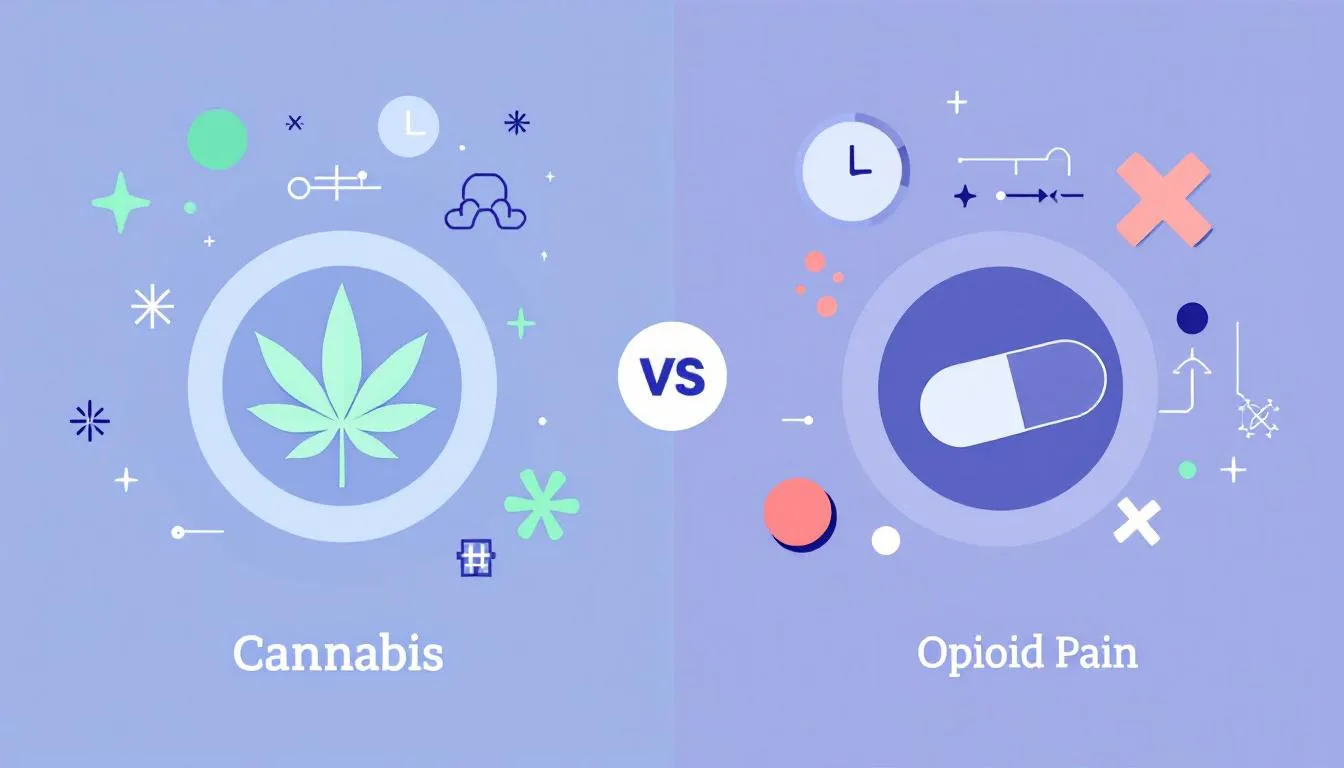Cannabis is increasingly recognized for its potential in managing chronic pain. Recent research highlights its effectiveness in alleviating pain and improving quality of life for patients suffering from cannabis and chronic pain. Unlike traditional medications, cannabis offers a holistic approach, addressing both physical and emotional aspects of pain. This article explores the role of cannabis in chronic pain management, its mechanisms of action, comparison with opioids, available forms, legal considerations, clinical evidence, and future directions in research.
Key Takeaways
- Medical cannabis offers a holistic approach to chronic pain management, providing not only pain relief but also improvements in emotional wellbeing and quality of life.
- Cannabinoids interact with the endocannabinoid system to modulate pain perception, demonstrating efficacy comparable to traditional opioids with milder side effects.
- The legal landscape and patient preferences significantly influence the accessibility of medical cannabis, highlighting the need for ongoing advocacy and education in this area.
Introduction to Chronic Pain
Chronic pain is a persistent and often debilitating condition that affects millions of individuals worldwide. Defined as pain lasting longer than three months, it can arise from a variety of causes, including injury, underlying disease, or nerve damage. Chronic pain not only limits physical activity but also takes a toll on emotional and mental health, often leading to anxiety, depression, and a reduced quality of life. Managing chronic pain is a significant challenge, as traditional pain management strategies—such as prescription opioids—can provide relief but are frequently associated with serious side effects, dependency, and the risk of overdose. These limitations have fueled a growing interest in alternative approaches, with medical cannabis emerging as a promising option for those seeking safer and more effective pain management solutions.
The Growing Role of Medical Cannabis in Chronic Pain Management

Cannabis has been recognized for its pain-relieving benefits across various medical conditions for centuries. Historically, it has been used to treat ailments like chronic pain and anxiety, and its reputation as a medicinal herb continues to grow. Today, chronic pain remains a common complaint that medical cannabis is increasingly managing, offering hope to those who have not found relief through traditional medications.
Recent findings suggest that medical cannabis alleviates pain by holistically altering the pain experience, impacting not just the physical sensation of pain but also the emotional and psychological dimensions. This multifaceted approach to pain relief sets it apart from conventional pain medications, which often focus solely on dulling the pain sensation.
Medical cannabis has shown to provide adequate pain management compared to traditional medications, offering a viable alternative for chronic pain patients. Unlike opioids, medical cannabis positively affects broader pain-related factors such as emotion, functionality, and wellbeing. This holistic impact is particularly valuable for chronic pain patients, who often suffer from a range of symptoms beyond pain alone.
Patients using medicinal cannabis have reported significant enhancements in health-related quality of life, with reductions in symptoms like pain, insomnia, anxiety, and depression. This comprehensive improvement in wellbeing is a testament to the potential of medical cannabis as a transformative treatment option for chronic pain.
Participants with chronic pain have also reported better emotional wellbeing and reduced anxiety and depression, indicating a positive shift in mental health associated with medical cannabis use. These mental health benefits further underscore the unique advantages of medical cannabis over traditional pain treatments.
As more states legalize medical cannabis and more patients seek alternatives to opioids, the role of medical cannabis in chronic pain management is poised to grow even further. The ongoing opioid epidemic has highlighted the need for safer, more effective pain management options, and medical cannabis is emerging as a promising solution.
The expanding body of research and patient testimonials continue to support the use of medical cannabis for chronic pain. As more patients and healthcare providers recognize its benefits, medical cannabis is likely to become an integral part of chronic pain management strategies, offering hope and relief to millions of individuals.
Mechanisms of Action: How Cannabis Alleviates Pain
Understanding how cannabis alleviates pain requires a deep dive into the endocannabinoid system, which plays a key role in regulating pain and inflammation. This system comprises receptors, endogenous cannabinoids, and enzymes that work together to maintain homeostasis in the body, including pain modulation.
Cannabinoids, including THC and CBD, engage with specific receptors in the body to influence pain perception. THC primarily binds to CB1 receptors in the brain and central nervous system, while CBD interacts with CB2 receptors found in immune cells, modulating pain and inflammation. Together, these cannabinoids decrease nociception—the sensory perception of pain—and reduce symptom frequency.
CBD, in particular, has been shown to have anti-inflammatory properties, which can contribute to pain relief. CBD’s anti-inflammatory properties help alleviate chronic pain conditions like arthritis and neuropathic pain. This anti-inflammatory action plays a key role in how medical cannabis manages pain.
Research supports that medical cannabis holistically alters the pain experience, reducing physical pain and improving emotional and psychological wellbeing, resulting in a more effective pain management strategy.
Studies on how plant cannabinoids interact with pain pathways are crucial for optimizing medical cannabis use and developing new formulations that enhance its therapeutic benefits.
Medical cannabis offers a comprehensive approach to pain management, particularly benefiting chronic pain patients who experience a range of symptoms beyond physical pain, including emotional and psychological distress. Medical marijuana can also play a role in this holistic approach.
Research on the mechanisms of action of cannabis highlights its potential in pain management. Understanding the interactions between cannabinoids and the endocannabinoid system will likely enhance the role of medical cannabis in treating chronic pain.
Comparing Cannabis and Opioids for Chronic Pain Relief

Cannabinoids and prescription opioids work through different mechanisms to alleviate pain, offering distinct benefits and drawbacks. Studies indicate that cannabinoids can offer pain relief comparable to codeine, with generally milder side effects than those associated with opioids.
Chronic pain patients have reported notable improvements in pain intensity and daily activities after using medical cannabis, which offers significant advantages in functionality and quality of life over opioids, often accompanied by severe side effects.
Issues can arise from opioid analgesics as a treatment for chronic pain, including severe constipation, respiratory depression, and opioid consumption dependence. These side effects can significantly impact a patient’s quality of life and even lead to life-threatening conditions. In contrast, the overall side effects of cannabinoids are generally milder and more manageable.
Although cannabinoids offer benefits, they do not significantly help with acute postoperative or most musculoskeletal pain conditions, underscoring the need for a multifaceted approach to pain management.
Cannabinoids may not reduce opioid usage in cancer-related pain patients, even as an effective adjunctive treatment, indicating that medical cannabis may not entirely replace opioids for certain pain types.
Studies have highlighted that cannabinoids might help reduce nausea, which is often a side effect of traditional pain treatments. This additional benefit can improve the overall treatment experience for patients, making medical cannabis a valuable adjunctive therapy.
The opioid epidemic has underscored the need for safer, more effective pain management options, including the reconsideration of opioid prescriptions. Medical cannabis offers a promising alternative, providing comparable pain relief with fewer and milder side effects. As research continues to explore the potential of cannabinoids, their role in chronic pain management is likely to expand.
The growing body of evidence comparing cannabis and opioids highlights the unique advantages of medical cannabis. By offering effective pain relief with fewer risks, medical cannabis is emerging as a safer, more sustainable option for chronic pain patients.
Forms of Medical Cannabis and Patient Preferences

Medical cannabis comes in various forms, each with its own set of advantages and patient preferences. A survey showed that 65% of patients prefer oils and tinctures for their ease of use and precise dosing.
Topical creams, used by 37% of surveyed chronic pain patients, are beneficial for localized pain treatment, offering targeted relief without psychoactive effects and serving as a form of pain medicine.
More than half of current users in a fibromyalgia study reported smoking smoked cannabis as their primary method of cannabis use, which, despite its rapid onset of effects, carries potential respiratory risks.
In a cohort study, the combination of dried cannabis and cannabis oil became the most commonly used form among chronic pain patients. This combination provides both immediate and sustained relief, catering to the diverse needs of chronic pain patients and is also supported by findings in J Cannabis Res.
Women preferred tinctures and topical medicines over smoking or vaporizing, highlighting the need for diverse cannabis product offerings to meet various patient needs.
New delivery methods like topical applications and inhalers aim to enhance efficacy and reduce side effects, providing safer and more effective options for medical cannabis patients.
The variety of medical cannabis products enables patients to choose forms that best suit their needs and preferences, which is crucial for effective pain management.
Ongoing research into new delivery methods and formulations will likely expand options for medical cannabis patients, ensuring access to the most effective and convenient treatments.
Legal Landscape: Medical Cannabis Laws and Accessibility
The legal status of medical cannabis varies significantly from state to state, directly influencing accessibility for chronic pain patients. As a Schedule I controlled substance, cannabis is viewed as having high abuse potential and no accepted medical use under federal law, posing significant barriers to research and access.
However, 38 states and Washington, D.C., have endorsed medical cannabis usage, with several states legalizing recreational cannabis for recreational purposes, reflecting a shift in public perception and recognition of its potential benefits.
Legal frameworks for medical cannabis vary from strict to lenient, impacting availability and accessibility. In states with restrictive laws, patients may face challenges in obtaining medical cannabis, limiting its potential as a treatment option.
In states with lenient laws, patients have broader access to medical cannabis, enabling them to explore its pain management benefits.
The disparity in cannabis laws across states highlights the need for a unified approach to medical cannabis legislation. Federal legalization could streamline access and facilitate research, benefiting patients and healthcare providers.
As the legal landscape evolves, policymakers must consider the needs and perspectives of chronic pain patients, ensuring that medical cannabis is accessible and affordable to maximize its potential as a pain management tool.
Ongoing changes in cannabis laws and accessibility reflect a trend towards recognizing the value of medical cannabis. Continued advocacy for legalizing medical cannabis reforms will ensure more patients can access this promising treatment option.
Clinical Evidence: Systematic Reviews and Meta-Analyses
The body of clinical evidence supporting medical cannabis for chronic pain management is growing, with systematic reviews and meta-analyses providing valuable insights. Cannabinoids can offer moderate pain relief in chronic non-cancer pain cases, particularly neuropathic pain, where traditional treatments often fall short.
Patients using non-inhaled medical cannabis reported small to very small improvements in pain relief, physical functioning, and sleep quality compared to placebo, suggesting that while not a cure-all, medical cannabis offers tangible benefits.
A systematic review aimed to assess the benefits and risks of medical cannabis for chronic pain, offering a comprehensive overview of current evidence, essential for understanding its true potential and limitations, including pain a systematic review.
Research limitations on medical cannabis for pain management largely stem from its classification as a Schedule I drug in the USA, restricting funding and access for research and creating significant barriers to scientific progress.
The meta-analysis included at least 10 studies to assess small study effects, ensuring a robust evidence base. A total of 77 articles were selected during the mixed methods systematic review process, reflecting extensive research efforts to understand cannabis efficacy.
Several transient adverse side effects associated with medical cannabis were highlighted in the systematic review. While generally mild, these side effects underscore the importance of monitoring and managing potential risks.
The most frequently reported adverse events related to medical cannabis include:
- Cognitive impairment
- Vomiting
- Dizziness
- Impaired attention
While typically mild, these side effects can impact a patient’s quality of life outcomes and should be carefully considered, as there may be negative effects on their overall well-being, resulting in a significant difference.
Ongoing research aims to explore the long-term safety and effectiveness of cannabis in chronic pain management, focusing on optimal dosing and patient outcomes. This research is crucial for developing guidelines and best practices for medical cannabis use.
The growing body of clinical evidence supports medical cannabis as a valuable tool in chronic pain management. Continued research will help maximize its benefits while minimizing risks.
Addressing Chronic Cancer and Non-Cancer Pain with Cannabis

Medical cannabis shows promise in addressing both chronic cancer-related and non-cancer pain, though effectiveness varies with the type of pain. Clinical trials indicate that THC can significantly relieve pain in patients with advanced cancer, especially those not finding relief through other medications.
However, cannabinoids are less effective for chronic cancer related pain compared to non-cancer pain, indicating the need for tailored pain management strategies based on the specific type of chronic pain.
Medical cannabis has demonstrated significant effectiveness for chronic non-cancer pain, including chronic neuropathic pain, neuropathic and geriatric pain, which often respond well to cannabinoids’ analgesic effects.
Studies suggest that chronic nonmalignant pain, including conditions like arthritis and chronic pelvic pain, may particularly benefit patients with chronic pain from medical cannabis to treat chronic pain and chronic noncancer pain condition, where traditional treatments often fall short.
Trials for medical cannabis included patients with both chronic non-cancer and cancer-related pain, offering a comprehensive understanding of its use in managing different types of chronic pain through randomised clinical trials.
The systematic review and meta-analysis on medical cannabis addressed both chronic non-cancer and cancer-related pain, ensuring the findings are relevant to a broad spectrum of chronic pain patients.
The analgesic effects of cannabinoids vary depending on the pain type; for instance, THC is effective for cancer-related pain, while CBD may be more beneficial for inflammatory and neuropathic pain.
Understanding how medical cannabis addresses different types of chronic pain enables healthcare providers to tailor treatment plans to individual needs, enhancing effectiveness and improving patient outcomes.
Potential Risks and Side Effects of Medical Cannabis
While medical cannabis offers significant benefits for chronic pain management, potential risks and side effects must be considered. Long-term use can lead to cognitive impairments, especially in younger individuals, potentially causing memory problems and slower reaction times.
Side effects of medical cannabis may include increased heart rate and dizziness, which, though generally mild, can impact quality of life. Clinical studies show that adverse effects from cannabinoid treatments are typically mild and well tolerated, with serious side effects being uncommon.
Some patients may experience more severe side effects like hallucinations and mental health issues, highlighting the health effects of closely monitoring and adjusting treatment plans as needed.
Pregnant individuals using cannabis may face complications such as early labor. This highlights the need for caution and further research into the effects of cannabis use during pregnancy.
Research is increasingly focusing on the balance between the therapeutic benefits of cannabinoids and the risks of dependency, particularly with THC. Understanding this balance is crucial for developing guidelines that maximize the benefits of medical cannabis while minimizing its risks.
The potential for cognitive issues like memory problems and slower reaction times with cannabis use is a concern that should not be overlooked. Patients and healthcare providers must weigh these risks against the benefits of pain relief and improved quality of life.
By being aware of the potential risks and side effects of medical cannabis, patients and healthcare providers can make informed decisions about its use. This awareness is essential for ensuring that medical cannabis is used safely and effectively for chronic pain management.
Patient Perspectives: Quality of Life and Emotional Wellbeing
Patient perspectives are crucial in understanding the true impact of medical cannabis on quality of life and emotional wellbeing. Reports indicate that while THC may not completely eliminate pain, it can enhance coping with discomfort. This coping ability is a significant benefit for patients who struggle with chronic pain on a daily basis.
Patients suffering from chronic pain conditions like fibromyalgia and rheumatoid arthritis have reported positive responses to cannabinoid therapies. These positive responses include not only pain relief but also improvements in overall wellbeing and daily functioning.
Long-term use of medical cannabis has been associated with sustained improvements in fatigue and sleep disturbances among chronic pain patients. These improvements contribute to a better quality of life, allowing patients to engage more fully in their daily activities.
The choice of cannabis products among patients often depends on their previous experience and the specific reason for their usage. This highlights the importance of offering a variety of cannabis products to meet the diverse needs of chronic pain patients.
Chronic pain patients exhibit a stronger support for expanding cannabis access compared to the physicians treating them. This support underscores the importance of considering chronic pain patients perspectives and patient groups in policy decisions regarding medical cannabis.
A significant portion of chronic pain patients favor mandating insurance coverage for cannabis treatment, indicating a demand for better accessibility. This demand reflects the growing recognition of medical cannabis as a valuable treatment option for chronic pain.
Patient reports suggest that medical cannabis can have a profound impact on mental health, reducing symptoms of anxiety and depression. These mental health benefits further enhance the overall quality of life for chronic pain patients.
By considering patient perspectives, healthcare providers can better understand the full impact of medical cannabis on quality of life and emotional wellbeing. This understanding is essential for developing comprehensive and effective pain management strategies.
Competing Interests and Research Transparency
As interest in medical cannabis for chronic pain management grows, it is important to recognize the need for transparency and objectivity in research. The field of cannabis for chronic pain is still evolving, and some studies may be influenced by competing interests, such as funding from organizations with a stake in medical cannabis products. To ensure that pain management recommendations are based on reliable evidence, it is crucial that research is conducted with rigorous methodology, unbiased funding sources, and full disclosure of any potential conflicts of interest. By prioritizing research transparency, the medical community can build trust in the findings and make informed decisions about the role of medical cannabis in chronic pain management, ultimately improving outcomes for patients with chronic pain.
Future Directions in Medical Cannabis Research

The future of medical cannabis research is bright, with numerous opportunities for advancing our understanding and optimizing its use for chronic pain management. There is a notable call for enhanced education in medical schools regarding cannabis treatment for chronic pain, reflecting an awareness of its potential benefits. This education is crucial for preparing future healthcare providers to effectively incorporate medical cannabis into their practice.
Ongoing research is essential to fully understand and optimize the use of medical cannabis for chronic pain management. This research will help identify the most effective formulations, dosages, and delivery methods for different types of pain.
Future studies may explore new formulations of cannabis extracts and innovative delivery methods to improve therapeutic effects. These innovations could enhance the efficacy and safety of medical cannabis, making it an even more valuable tool for pain management.
The integration of medical cannabis into chronic pain management requires a commitment to research and education to ensure safe and effective use. This commitment will help address the current gaps in knowledge and improve patient outcomes.
As research continues to evolve, it will be important to focus on long-term safety and effectiveness, particularly regarding optimal dosing and patient outcomes. This focus will help ensure that medical cannabis is used in a way that maximizes its benefits while minimizing its risks.
The future of medical cannabis research also includes exploring the potential benefits of cannabinoids for other medical conditions beyond chronic pain. This broader research agenda could uncover new therapeutic applications for cannabis, further expanding its role in medicine.
Education and research will be key to integrating medical cannabis into mainstream medical practice. By equipping healthcare providers with the knowledge and tools they need, we can ensure that patients receive the most effective and safe treatments available.
The ongoing advancements in medical cannabis research hold great promise for the future. As we continue to explore and understand its full potential, medical cannabis is likely to become an even more integral part of chronic pain management and beyond.
Summary
In summary, medical cannabis offers a promising alternative for chronic pain management, providing effective pain relief with fewer and milder side effects compared to traditional pain medications. The growing body of clinical evidence supports its efficacy, particularly for conditions like neuropathic pain and chronic non-cancer pain.
Patient perspectives highlight the significant improvements in quality of life and emotional wellbeing associated with medical cannabis use. These benefits, coupled with the ongoing research and innovation in cannabis formulations and delivery methods, underscore the potential of medical cannabis as a transformative tool in pain management.
As we look to the future, continued research and education will be essential for optimizing the use of medical cannabis and ensuring that it is accessible to all patients who could benefit from it. By embracing the potential of medical cannabis, we can offer new hope and relief to millions of individuals struggling with chronic pain.
FAQs
How does medical cannabis work to alleviate pain?
Medical cannabis provides pain relief through its interaction with the body’s endocannabinoid system, which plays a key role in regulating pain and inflammation. The primary cannabinoids found in medical cannabis products—THC (tetrahydrocannabinol) and CBD (cannabidiol)—work together to modulate pain signals. THC binds to cannabinoid receptors in the brain and spinal cord, reducing the perception of pain and dampening inflammatory responses. CBD, known for its anti-inflammatory and antioxidant properties, can further help reduce pain and inflammation without causing psychoactive effects. When combined, these cannabinoids can enhance pain relief and minimize side effects, making medical cannabis a valuable option for those seeking effective pain management.
How does medical cannabis compare to opioids for chronic pain relief?
Medical cannabis has demonstrated effectiveness in reducing chronic pain, particularly for conditions such as neuropathic pain, chronic noncancer pain, and cancer-related pain. Compared to prescription opioids, medical cannabis is associated with a lower risk of addiction, overdose, and other serious side effects. While opioids can be effective for acute pain, their long-term use for chronic pain management often leads to complications and dependency. Medical cannabis, on the other hand, offers a more favorable safety profile and can be used alongside other pain treatments, such as physical therapy and behavioral interventions, to provide a comprehensive approach to pain relief. However, more research—including randomized clinical trials—is needed to fully understand how medical cannabis and opioids compare in terms of long-term effectiveness and safety for chronic pain patients.
What are the most common forms of medical cannabis?
Medical cannabis is available in a variety of forms to suit different pain conditions and patient preferences. Smoked cannabis remains a common choice for its rapid onset of pain relief, but vaporized cannabis and edibles are increasingly popular due to their convenience and reduced respiratory risks. Oils and tinctures offer precise dosing and can be taken sublingually, while topicals are applied directly to the skin for localized pain relief. The choice of medical cannabis form often depends on the type of pain being treated, the desired speed of relief, and individual lifestyle factors, allowing patients to tailor their pain management approach to their unique needs.
What are the potential risks and side effects of using medical cannabis?
While medical cannabis is generally well tolerated, it can cause side effects such as dizziness, dry mouth, and short-term memory impairment. In rare cases, more serious effects like cognitive impairment, psychosis, or increased heart rate may occur, particularly in individuals with a history of mental health conditions or substance use disorder. Medical cannabis can also interact with other medications, including blood thinners and sedatives, potentially leading to adverse effects. It is important for patients to consult with a healthcare professional before starting medical cannabis, especially if they have underlying health conditions or are taking other medications, to ensure safe and effective pain management.
How does medical cannabis work to alleviate pain?
Medical cannabis alleviates pain by interacting with the endocannabinoid system, influencing pain perception and reducing inflammation through cannabinoids like THC and CBD. This targeted mechanism makes it an effective option for managing pain.
How does medical cannabis compare to opioids for chronic pain relief?
Medical cannabis provides comparable pain relief to opioids, such as codeine, while generally presenting milder side effects. Additionally, it benefits emotional health, functionality, and overall well-being, making it a viable alternative for chronic pain management.
What are the most common forms of medical cannabis?
The most common forms of medical cannabis are oils and tinctures, topical creams, and smoked cannabis, with oils and tinctures often preferred for their ease of use and precise dosing. Ultimately, the choice depends on individual patient preferences.
What are the potential risks and side effects of using medical cannabis?
The potential risks and side effects of medical cannabis include cognitive impairments, increased heart rate, dizziness, and, in severe cases, hallucinations and mental health issues. Close monitoring of patients is essential to manage these effects effectively.
What does the future hold for medical cannabis research?
The future of medical cannabis research promises advancements in formulations and delivery methods while prioritizing education and comprehensive studies to establish its long-term safety and effectiveness. This will ultimately optimize medical cannabis applications, particularly for chronic pain management.





